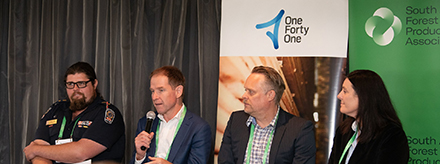Funding to support disaster resilience in the primary industries has been highlighted at a South Australian Forest Products Association disaster resilience summit in Mt Gambier. Source: Timberbiz
A new pilot project led by the Department of Primary Industries and Regions (PIRSA) and Primary Producers SA (PPSA) has received $770,000 from the State Government’s Disaster Risk Reduction grant program to prepare the agricultural sector and mitigate the impacts of compounding and increasingly complex natural disasters.
Funded through a national partnership agreement between the Commonwealth and South Australian Governments, the project takes an industry-led approach to minimising disruptions to supply chains and maintaining the production and profitability of regional communities.
This support is subsequent to the $26.7 million investment made by the Malinauskas Government to increase the Country Fire Service’s aerial firefighting fleet, which for the first time has seen a Blackhawk helicopter with 4,500 litre capacity for water and foam substantively based at Mount Gambier during the 2023–24 fire danger season.
Additionally, the upgrade of the latest fire observation tower in Lucindale South has now been completed featuring game changing artificial intelligence (technology now rolled out across the region. The cameras are now fully operational at Comaum, Mount Benson, The Bluff, Carpenter Rocks, Mount Burr and Furner.
It is the first time the Pano AI system has been implemented commercially in Australia as part of the South Australian Government’s $2.3 million fire tower network upgrade project, with $1 million targeting the new technology – and it has already been able to assist with early detection of several bushfires in the South East.
“This new pilot program funded by SAFECOM and delivered by the Department of Primary Industries and Regions (PIRSA) and Primary Producers South Australia (PPSA), provided the South Australian Forest Products Association an opportunity to host a Disaster Resilience Summit bringing together all the agricultural commodity groups with community groups and key decision markers in an effort to focus on how to mitigate the impacts of compounding and complex disasters,” South Australian Forest Products Association CEO Nathan Paine said.
“One thing that Covid taught us all, is that disasters can come at any time and we can never be too prepared. These disasters include bushfires, floods, heatwaves and extreme winters, pandemics, animal, and plant diseases, and we need to ensure that we are all integrated with our approach when it comes to disaster management,” he said.
“SAFPA’s Disaster Resilience Summit attracted significant guest speakers to address the 80 plus crowd who attended from across the State and Victoria, to understand how authorities and community members can minimize the disruptions to supply chains, ensure production maintenance continues in the event of a disaster and most important, how we can support the community to recover after a disaster.
“SAFPA acknowledge the ongoing support of the State Government, particularly the Minister for Forest Industries, The Honourable Clare Scriven, and the Minister for Emergency Services, The Honourable Joe Szakacs, who both attended and spoke at the Summit. Their attendance highlights how important the State Government values our regional economies and how committed they are to safeguarding lives, property and infrastructure in the region.”
Along with the Ministers, the Summit attracted the following speakers:
- Jonathon Pollock, Bureau of Meteorology
- Jason Taylor, Limestone Coast Landscape Board
- Cameron MacDonald, OneFortyOne
- Caroline Rhodes, Primary Producers South Australia
- Alex Zimmerman, Community recovery Coordinator, SA Government
- Brett Loughlin, Chief, SA Country Fire Service
- Anthony Walsh, Green Triangle Fire Alliance
- Andrew Prolov, PANO AI
- Jason Wallace, ac.care
- Andrew Excel, Department of Infrastructure and Transport
- Georgina Goodrich, Department of Premier and Cabinet
“Industry and Government have a strong partnership and are working together to reduce the impacts of disaster. Currently, SA’s forest industries invest $13 million every year into fire detection, prevention and response, including fire fighters, specialist firefighting tankers, and associated equipment,” Mr Paine said.
“With industry’s investment along the State Government’s additional investments into upgrading fire tower network with new technology and increasing the Country Fire Services aerial firefighting fleet with a Blackhawk helicopter, the Limestone Coast is well prepared to combat any compounding and complex disasters.
“Thank you to our partners, SAFECOM with Department of Primary Industries and Regions and Primary Producers South Australia, OneFortyOne and Limestone Coast Landscape Board, for their support for this ever-important Summit. SAFPA are working in step with industry and government authorities to ensure the Limestone Coast are well prepared in crisis management, mitigation and recovery,” he said.






